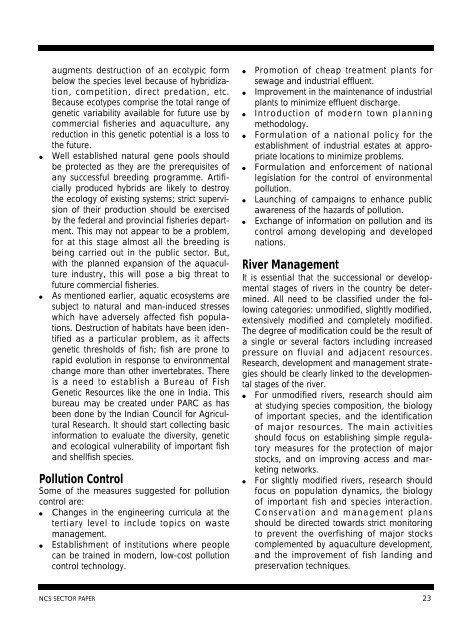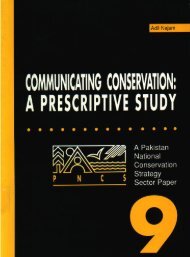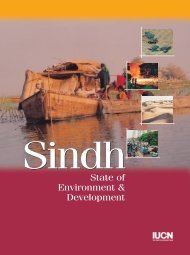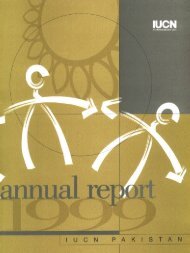Sustainable Fisheries - Pakistan Water Gateway
Sustainable Fisheries - Pakistan Water Gateway
Sustainable Fisheries - Pakistan Water Gateway
Create successful ePaper yourself
Turn your PDF publications into a flip-book with our unique Google optimized e-Paper software.
●<br />
●<br />
augments destruction of an ecotypic form<br />
below the species level because of hybridization,<br />
competition, direct predation, etc.<br />
Because ecotypes comprise the total range of<br />
genetic variability available for future use by<br />
commercial fisheries and aquaculture, any<br />
reduction in this genetic potential is a loss to<br />
the future.<br />
Well established natural gene pools should<br />
be protected as they are the prerequisites of<br />
any successful breeding programme. Artificially<br />
produced hybrids are likely to destroy<br />
the ecology of existing systems; strict supervision<br />
of their production should be exercised<br />
by the federal and provincial fisheries department.<br />
This may not appear to be a problem,<br />
for at this stage almost all the breeding is<br />
being carried out in the public sector. But,<br />
with the planned expansion of the aquaculture<br />
industry, this will pose a big threat to<br />
future commercial fisheries.<br />
As mentioned earlier, aquatic ecosystems are<br />
subject to natural and man-induced stresses<br />
which have adversely affected fish populations.<br />
Destruction of habitats have been identified<br />
as a particular problem, as it affects<br />
genetic thresholds of fish; fish are prone to<br />
rapid evolution in response to environmental<br />
change more than other invertebrates. There<br />
is a need to establish a Bureau of Fish<br />
Genetic Resources like the one in India. This<br />
bureau may be created under PARC as has<br />
been done by the Indian Council for Agricultural<br />
Research. It should start collecting basic<br />
information to evaluate the diversity, genetic<br />
and ecological vulnerability of important fish<br />
and shellfish species.<br />
Pollution Control<br />
Some of the measures suggested for pollution<br />
control are:<br />
●<br />
●<br />
Changes in the engineering curricula at the<br />
tertiary level to include topics on waste<br />
management.<br />
Establishment of institutions where people<br />
can be trained in modern, low-cost pollution<br />
control technology.<br />
●<br />
●<br />
●<br />
●<br />
●<br />
●<br />
●<br />
Promotion of cheap treatment plants for<br />
sewage and industrial effluent.<br />
Improvement in the maintenance of industrial<br />
plants to minimize effluent discharge.<br />
Introduction of modern town planning<br />
methodology.<br />
Formulation of a national policy for the<br />
establishment of industrial estates at appropriate<br />
locations to minimize problems.<br />
Formulation and enforcement of national<br />
legislation for the control of environmental<br />
pollution.<br />
Launching of campaigns to enhance public<br />
awareness of the hazards of pollution.<br />
Exchange of information on pollution and its<br />
control among developing and developed<br />
nations.<br />
River Management<br />
It is essential that the successional or developmental<br />
stages of rivers in the country be determined.<br />
All need to be classified under the following<br />
categories: unmodified, slightly modified,<br />
extensively modified and completely modified.<br />
The degree of modification could be the result of<br />
a single or several factors including increased<br />
pressure on fluvial and adjacent resources.<br />
Research, development and management strategies<br />
should be clearly linked to the developmental<br />
stages of the river.<br />
● For unmodified rivers, research should aim<br />
at studying species composition, the biology<br />
of important species, and the identification<br />
of major resources. The main activities<br />
should focus on establishing simple regulatory<br />
measures for the protection of major<br />
stocks, and on improving access and marketing<br />
networks.<br />
●<br />
For slightly modified rivers, research should<br />
focus on population dynamics, the biology<br />
of important fish and species interaction.<br />
Conservation and management plans<br />
should be directed towards strict monitoring<br />
to prevent the overfishing of major stocks<br />
complemented by aquaculture development,<br />
and the improvement of fish landing and<br />
preservation techniques.<br />
NCS SECTOR PAPER 23
















